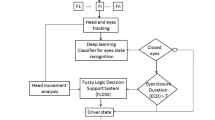Abstract
In this paper a Fuzzy Expert System for the prediction of Hypovigilance-related accidents is presented. The system uses physiological modalities in order to detect signs of extreme hypovigilance. An advantage of such a system is its extensibility regarding the physiological modalities and features that it can use as inputs. In that way, even though currently only eyelid-related features are exploited, in the future and for prototypes designed for professionals other physiological modalities, such as EEG can be easily integrated in the existing system in order to make it more robust and reliable.
Chapter PDF
Similar content being viewed by others
Keywords
These keywords were added by machine and not by the authors. This process is experimental and the keywords may be updated as the learning algorithm improves.
References
Akerstedt et al., “Work organisation and unintentional sleep: results from the WOLF study” Occup Environ Meaf 2002;59:595–600.
Dinges, Mallis, et al.: Evaluation of techniques for ocular measurement as an index of fatigue and the basis for alertness management. Final report for the USDOT, NHTSA, 104pp, Report No. DOT HS 808 762, 1998
Björn Peters, Anna Anund, Joakim Östlund and Magnus Hjälmdahl, Results of Sensation Pilot 2.5-WP1.7 (Alertness Monitoring Database), SENSATION internal deliverable, Nov. 2005.
Rechtschaffen, A., & Kales, A. (1968). A manual of standardized terminology, techniques and scoring system for sleep stages of human subjects. Bethesda: US Department of Health, Education and Welfare, Public Health Service.
N. Galley, R. Schleicher, L. Galley, “Blink parameter for sleepiness detection” and other works by the same authors.
Caffier, P.P., Erdmann, U., Ullsperger, P. Experimental evaluation of eye-blink parameters as a drowsiness measure. Eur J Appl Physiol, 89: 319–325. 2003.
Yannis Damousis, Dimitrios Tzovaras: Correlation between SP1 data and parameters and WP 4.4.2 algorithms, Sensation Internal Report (Draft Nov2004)
Z. Michalewicz, Genetic Algorithms + Data Structures = Evolution Programs, New York/USA, Springer-Verlag, 1996.
F. Herrera, M. Lozano, J.L. Verdegay, Tuning fuzzy controllers by genetic algorithms, Internal J. Approx. Reasoning 12 (1995) 299–315.
Alex H. Bullinger et al “Criteria and algorithms for physiological states and their transitions, SENSATION_Del_l_l_l.doc”, SENSATION Deliverable 1.1.1, August 2004.
Author information
Authors and Affiliations
Editor information
Editors and Affiliations
Rights and permissions
Copyright information
© 2006 International Federation for Information Processing
About this paper
Cite this paper
Damousis, I.G., Tzovaras, D., Strintzis, M.G. (2006). A Fuzzy Expert System for the Early Warning of Accidents Due to Driver Hypo-Vigilance. In: Maglogiannis, I., Karpouzis, K., Bramer, M. (eds) Artificial Intelligence Applications and Innovations. AIAI 2006. IFIP International Federation for Information Processing, vol 204. Springer, Boston, MA . https://doi.org/10.1007/0-387-34224-9_39
Download citation
DOI: https://doi.org/10.1007/0-387-34224-9_39
Publisher Name: Springer, Boston, MA
Print ISBN: 978-0-387-34223-8
Online ISBN: 978-0-387-34224-5
eBook Packages: Computer ScienceComputer Science (R0)




